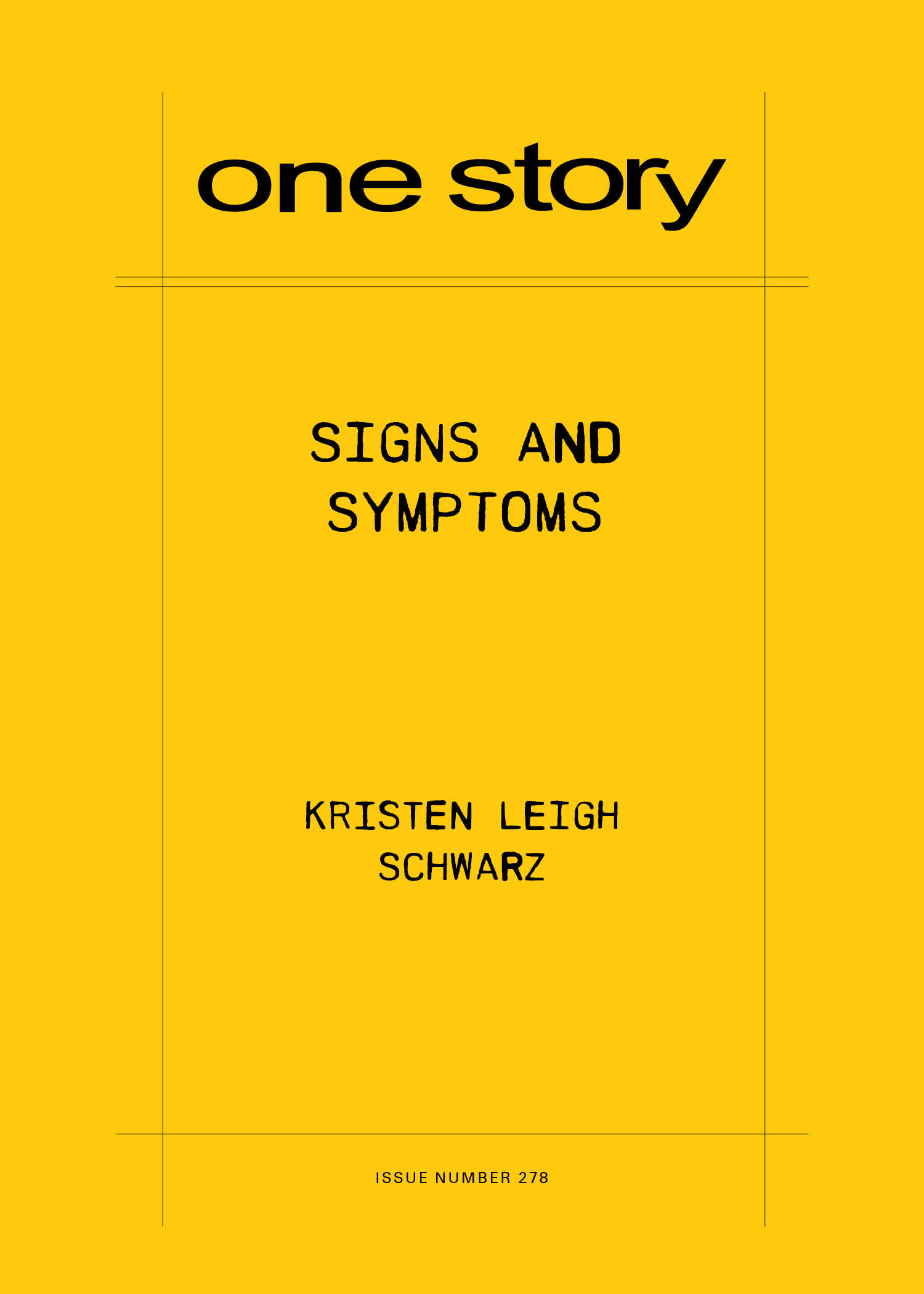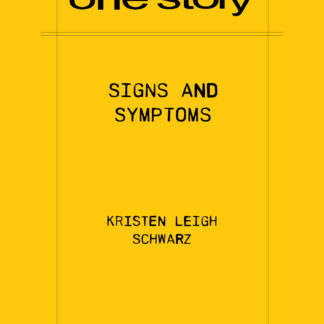
Signs and Symptoms
275 in stock
Excerpt
The first Marvin learns of the sign is in his car before work, scrolling through Facebook. Past the cat memes from mom’s friends, the club selfies from mostly Reg’s friends, and the increasingly shrill political pleas from his high school best friend who’d moved up to Los Angeles only to boil alive in the costs, the homelessness, the illegal dumping. Scrolling with groggy, trancelike intensity and no idea what he’s looking for every gray morning, here in the strip mall parking lot of Location #314 where he works, no idea what hole he aches to fill. Only one identifiable relief, as he drags the lives of his friends ever upward and out of sight: at least he’s out of the swiping game, for now.
Then, as if trying to blend in, the neighborhood group post rolls onscreen—a group he’d joined that was supposed to be like NextDoor but without the prejudice and the mystifyingly robust bazaar of free dirt. So much free dirt all the time! If the Inland Experience could be said to have natural resources, they were fill dirt and air for skydiving.
The picture is of a warzone, except it’s the Walmart—the “Walmart” sign on the Walmart, specifically. He looks at the time stamp: yesterday afternoon. Well, he doesn’t shop there, so. Of course he didn’t know.
In the photograph pinned under his thumb, the letters along the front of the building are black-stained, cracked. The W and the T have gone missing. The rest have been rearranged to spell “alarm,” the overfamiliar lowercase now unnerving.
Kristen Leigh Schwarz
Kristen Leigh Schwarz (she/her) grew up in Newhall, California, twenty-six miles outside Los Angeles. She holds an MFA from the University of California, Irvine, where she received the MacDonald Harris Award for Fiction and an award from the International Center for Writing and Translation to work in Mexico. Her stories have appeared in the Santa Monica Review, Indicia, the American Literary Review, and St. Ann’s Review, among other places. Her story “Emperor of Umbrellas” was anthologized in Orange County: A Literary Field Guide. Her recently completed novel is represented by Susanna Lea Associates.
Patrick Ryan on “Signs and Symptoms”
Every story has a spark that set it smoking in the writer’s mind, and the spark that set off our new issue, “Signs and Symptoms,” was a news article about a physicist’s attempting to open a portal into a parallel universe. Author Kristen Leigh Schwarz read the article and couldn’t help but wonder, How might that go?
How it goes for barista Marvin is that a series of bizarre and troubling phenomena first are reported in the news and then begin to occur in his place of work. The parallel universe, it seems, is vacuuming things out of this world at an alarming rate. Marvin and his boyfriend, Reg, have to think fast: Should they call for help? Run for their lives? Go to a casino and play nickel slots until this world and everything in it have been sucked into the void?
I love “Signs and Symptoms” because it manages to be so many things at once. It’s weird, fantastical, a little frightening, extremely funny, and romantic. Yes, this apocalyptic yarn is romantic! Kristen Leigh Schwarz has pulled off a kind of magic trick with this highly original story that is simultaneously down-to-Earth and out of this world. We hope you enjoy it as much as we did.
Q&A by Patrick Ryan
- PR: Where did the idea for this story come from?
- KS: A couple years back, I saw a tweet from NBC News that read, “At Oak Ridge National Laboratory, physicist Leah Broussard is trying to open a portal to a parallel universe.” To which someone had justifiably replied, “Maybe don’t?” (With apologies to the brilliant physicist Leah Broussard — I promise I wasn’t picturing her when I wrote about Jen.) Also, in Southern California, if you aren’t careful/lucky, you can spend a lot of time idling near, and idly contemplating, freeway signs.
- PR: How long did it take you to complete this story?
- KS: I started writing this story in the summer of 2019. Then I worked on it, on and off, over the next year and a half.
- PR: What was the most challenging aspect of writing this story?
- KS: Knowing how far to let out the leash on the apocalypse. In any story with a science fiction or surreal angle, I think the central challenge is balancing the humanity of the characters against the world-building and finding a way to honor both. It’s a fun challenge, though, which is why I keep finding myself back here.
- PR: How different is the finished product from the story you originally envisioned?
- KS: When I started writing, I knew about the Walmart sign and that it probably had something to do with mirror worlds, and I knew what I thought Marvin’s voice sounded like and that I wanted it to take place in the Inland Empire. That was it, no idea of plot. Then Marvin made spaghetti and his roommate came home, and the path forward started to emerge. The only part of those original notions that changed was I thought Marvin was more of a diva at first, big fish in a small pond. But I realized that attitude wouldn’t allow him to feel like much was at stake for him once things started going sideways, and it wasn’t letting me portray the Inland Empire the way I wanted to.
- PR: (Spoiler alert!) This apocalyptic tale is (also) a love story! Was it always (also) a love story?
- KS: I was surprised and delighted to discover that it was (also) a love story while I was writing it! I think I may have actually said “awww” out loud? I remember that revelatory line when he realizes it’s love was both our favorites.
- PR: (Another spoiler alert!) You never show us the beings in the mirror world. Is that because they look just like us? Or because they’re beside the point? Or because it heightened the creepy factor? (It did, by the way.)
- KS: It’s a little beside the point, maybe, which is just to say that showing them would start to let that leash out a little too much and tilt the story away from Marvin. Instead, not showing the mirror folks gives us the opportunity and the pleasure of experiencing Marvin’s fantasies about who they might be. It’s related to the reason why I was weirdly adamant about not naming the Omnipresent Coffee Purveyor where Marvin works, because I wanted us to experience it through his point of view as a barista instead of defaulting to our own understanding as the current, recovering, or lapsed Frappuccino consumers we all are. (And also, yes, vive la creepy.)
- PR: The voice throughout is very funny. The narrative cadence is nicely in keeping with how the characters think and speak. Is that usually the case in your fiction, or does the approach vary depending on the story?
- KS: I’ll forever be (gratefully) chasing David Mitchell and George Saunders in this department. It’s just one of the greatest pleasures when done well, that free indirect. Not everything I write is as voice-forward as this story, but from the beginning I wanted to do justice to the kind of personalities I grew up with (while also poking fun at them a little) and I wanted to provide a strong point of view to anchor all the bonkers stuff.
- PR: Can you tell us a little about the title? (The signs are pretty self-explanatory, but what about the symptoms? Symptoms of what?)
- KS: “Signs and Symptoms” is actually a pair of medical assessment categories. A sign is an objective phenomenon that can be identified by a doctor, like a bruise or a fever. A symptom is a subjective experience that can’t be identified or described by anyone other than the patient, like dizziness or loss of smell. Together, signs and symptoms help doctors piece together what’s really going on with a patient. That to me encapsulated the two aspects of this story—the weird artifacts that keep appearing and Marvin’s subjective experience as he tries to understand what’s happening.
- PR: What are you working on now?
- KS: I just finished up edits on a novel. It’s about a version of history in which the Mexica of Tenochtitlan successfully inoculate themselves against smallpox and Europeans, and then they spend the next 500 years making questionable medical advancements while haunted by the psychological and political fall-out of surviving an epidemic. I finished writing the book before 2020. So, I had some...additional thoughts to contribute after this last year.
- PR: What is the best bit of advice about writing you have ever received?
- KS: I’ve heard it said countless ways but it really all boils down to: stay in the chair. From Sister Corita Kent: “The only rule is work.” From Ron Carlson: “The writer is the person who stays in the room.” From Disneyland’s Matterhorn Bobsleds: “Permanecer sentados, por favor.” I often start writing a story knowing very little, and now, when I can feel my tolerance for the unknown start to waver, I know to nail myself to the seat, because the good stuff is coming.
